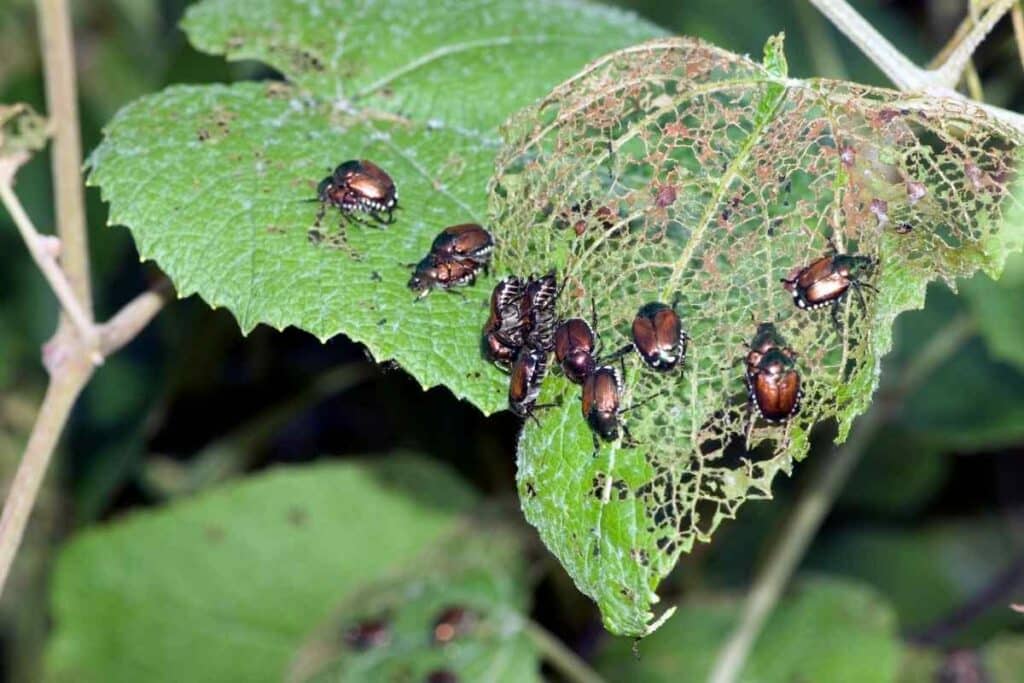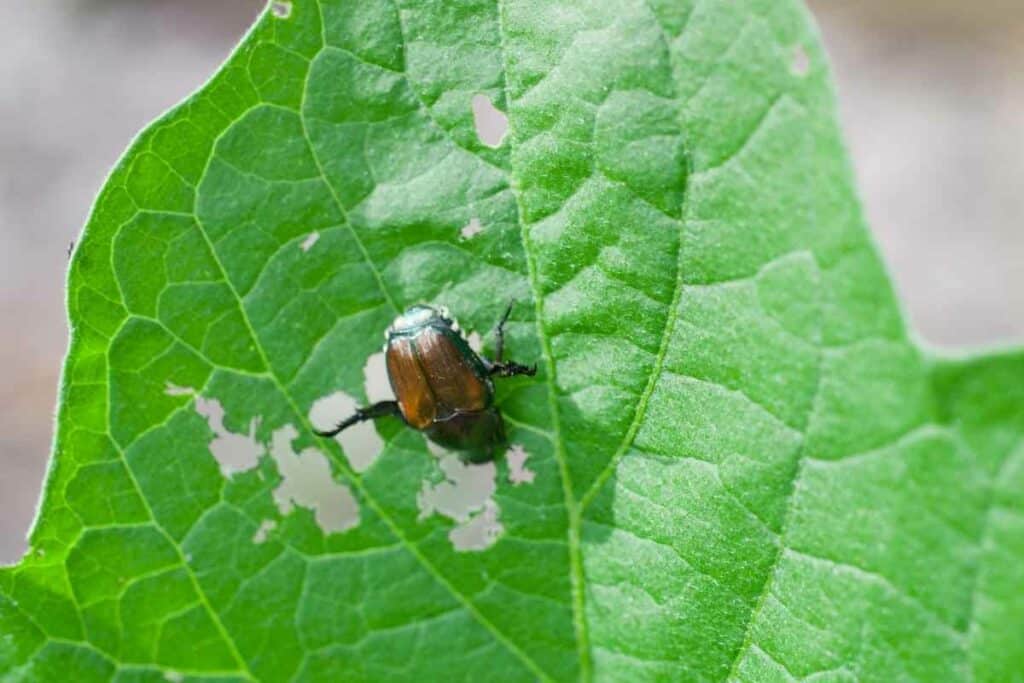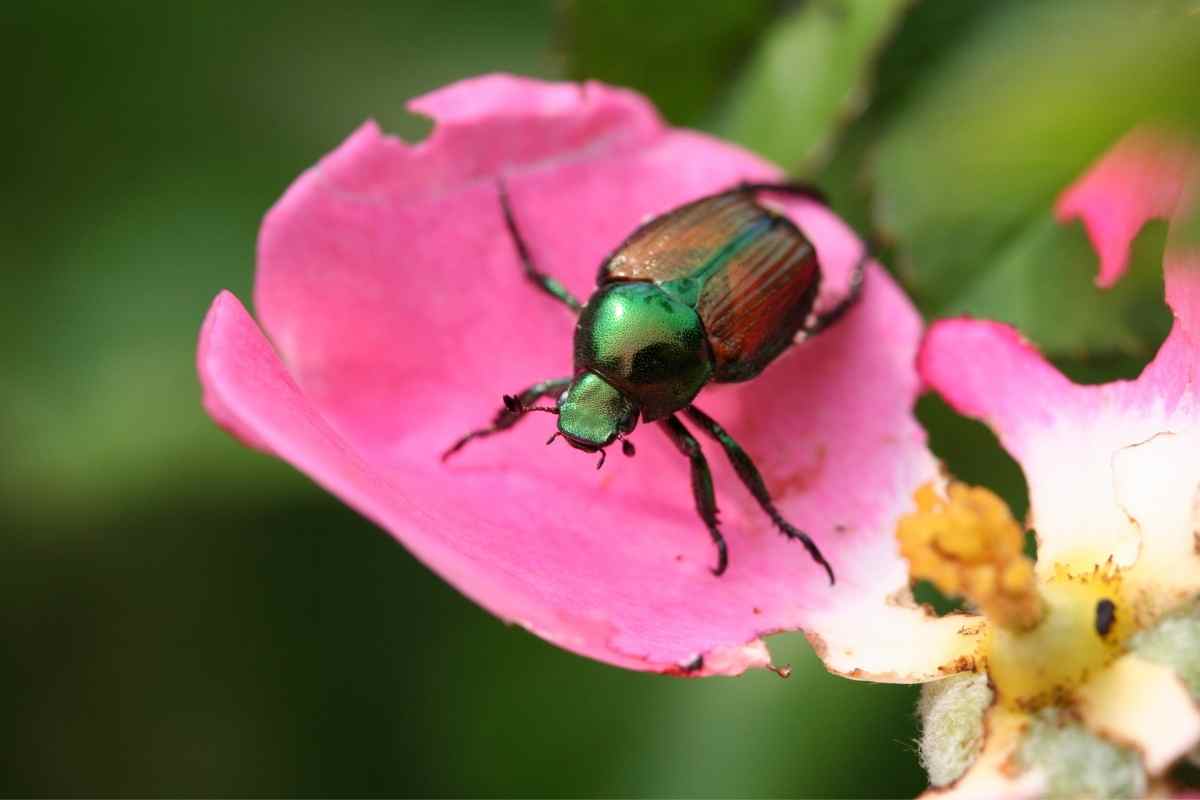Just like any worker after a hard day at the office, renowned pest the Japanese Beetle will clock off in the late afternoon and head to its nighttime nesting location to sleep on the ground in the nests they form at night.
If this beetle were not so destructive, its efficiency would be impressive.
But for millions of gardeners across the United States, Japanese beetle season heralds the onset of carnage among plants of all kinds.
If this iridescent beetle has you at your wit’s end, this concise guide to the Japanese beetle will equip you with all the essential information for bringing an infestation of this pest right under control!
So, Just What Are Japanese Beetles?
Popillia japonica, the Japanese beetle is a small, iridescent green and copper-colored beetle that is a type of scarab beetle.

As its name suggests, this beetle is native to Japan where its activities are kept under control by its natural predators.
But in North America, particularly the East and Mid-west, it has no predators and has become a pest of hundreds of crops, grass, ornamentals, trees, and shrubs!
They are highly adaptable and can make a home of just about anywhere that has some foliage to feed on.
Identifying the Japanese Beetle
An adult Japanese beetle is just over 15 millimeters in length and 10 millimeters in width.
Its wing casings are a beautiful copper color, which contrasts with its iridescent green thorax and head.
Underneath the wing covers sprout coarse white tufts of hair. Its wings are light brown.
The larvae of this beetle are large, curved grubs that can be up to an inch long. These larvae hatch and live in the soil where they actively feed on plant roots.
Once mature, Japanese beetles can be easily found eating in groups in daylight hours.
Have You Noticed: You can often catch them actively eating or on the ground near plants that they have been feeding on.
From Larval Stowaway to Cornfield Menace…
The so-far unopposed run of the Japanese beetle in the US began when it was accidentally introduced in the early twentieth century.
This is most likely to have been as larvae in the soil of imported plants.
At this time agricultural and environmental biosecurity were only beginning to be recognized and a ban on imports of plants rooted in soil failed to prevent the escape of this species into an entirely new environment.
By 1916 these island dwellers were already making themselves at home in New Jersey, meaning that they had already spanned the United States.
The Japanese Beetle Is a Prolific Feeder
The Japanese beetle has an industrial approach to literally dismantling plants in large numbers.
Their voracity means that they can devastate crops and cause cosmetic damage to gardens and grounds. Groups of these beetles will destroy plants by literally stripping all foliage between the veins of leaves.

Japanese beetles skeletonize plants by chewing off the leaf tissue, leaving a skeleton outline – a devastatingly distinctive calling card.
Fruits are not safe either as this beetle will target soft fruits, while even the larvae will feed off roots.
Look Out: The grubs can cause brown patches in lawns as they will feed off the grassroots and kill the blades.
And They Will Eat Just about Anything
Japanese beetles target over 300 plant species with a predilection for roses.
In the mid-west, they have made a name for themselves as formidable agricultural pests, eating beans, grapes, cherries, apples, maize and more!
A Mercifully Short Campaign
Thankfully, the Japanese beetle is relatively short-lived with marked seasonality in its campaigns.
But with a lifespan of fewer than 40 days, this bug can get a lot of damage done and ensure that it reproduces with plenty of eggs laid in your lawn to wreak havoc the following year.
Japanese Beetles Pull a 9 to 5 Shift Eating Vegetation and Then Head to Their Nests at Night
If you are not sure where Japanese beetles go at night, the answer is they head to nests of their own making to sleep.
They prefer to be out and about on warm days from late Spring until mid-August.
If you encounter beetles that are feeding at night during this period, they are likely to be Northern Masked Chafers which have a similar pattern of seasonal activity to the Japanese beetle but are nocturnal.
How to Bring Japanese Beetles under Control (Before Your Garden Is Overwhelmed)
Japanese beetle damage is an annual event in large parts of the US, but there are ways in which you can firefight their campaigns.

Organic control and eradication methods are reasonably effective if used diligently.
Here are some methods for you to try:
- Handpicking: simply pick these beetles off your plants and drop them in a bucket of soapy water. They do not have jaws that are strong enough to bite humans.
- Neem oil: this organic pesticide is very effective as the ingested oil will kill the larvae of the Japanese beetle.
- Covering crops: netting and covering can help to reduce damage, though you will need to uncover the crops for a period to enable them to be accessed by pollinators.
- Traps: you can purchase pheromone traps that attract the beetles to them. A simple fruit trap made of rotting fruit cocktail set in a bucket of soapy water can also be very effective.
- Sacrificial plants: geraniums are the “cat-nip” of the Japanese beetle. It will attract them to this plant but become woozy after eating it, making it easy to round up and dispose of them.
- Natural predators: parasitic nematode and wasp species can target and kill these beetles.
Once you’ve shown them the door, here are some strategies to prevent the return of the Japanese beetle:
- Cultivation is always key when keeping pests at bay.
- You can target Japanese beetle grubs early in their season while immature by introducing the milk spore fungus into your lawn. This will kill the larvae as they emerge.
- Grubs can also be eradicated by spraying dilute soapy water on your lawn. This will cause the Japanese beetle larvae to surface so that they can be eaten by birds.
- Distribute ornamental roses and other favored plants around your property. Companion planting will also help to protect your crops.
Rounding Up
As a hard-working gardener, it can be galling to see this cheeky beetle spend its days eating the plants and crops you are working hard on, but thankfully you have a range of options for getting your plants through the Japanese beetle season with minimal harm.
